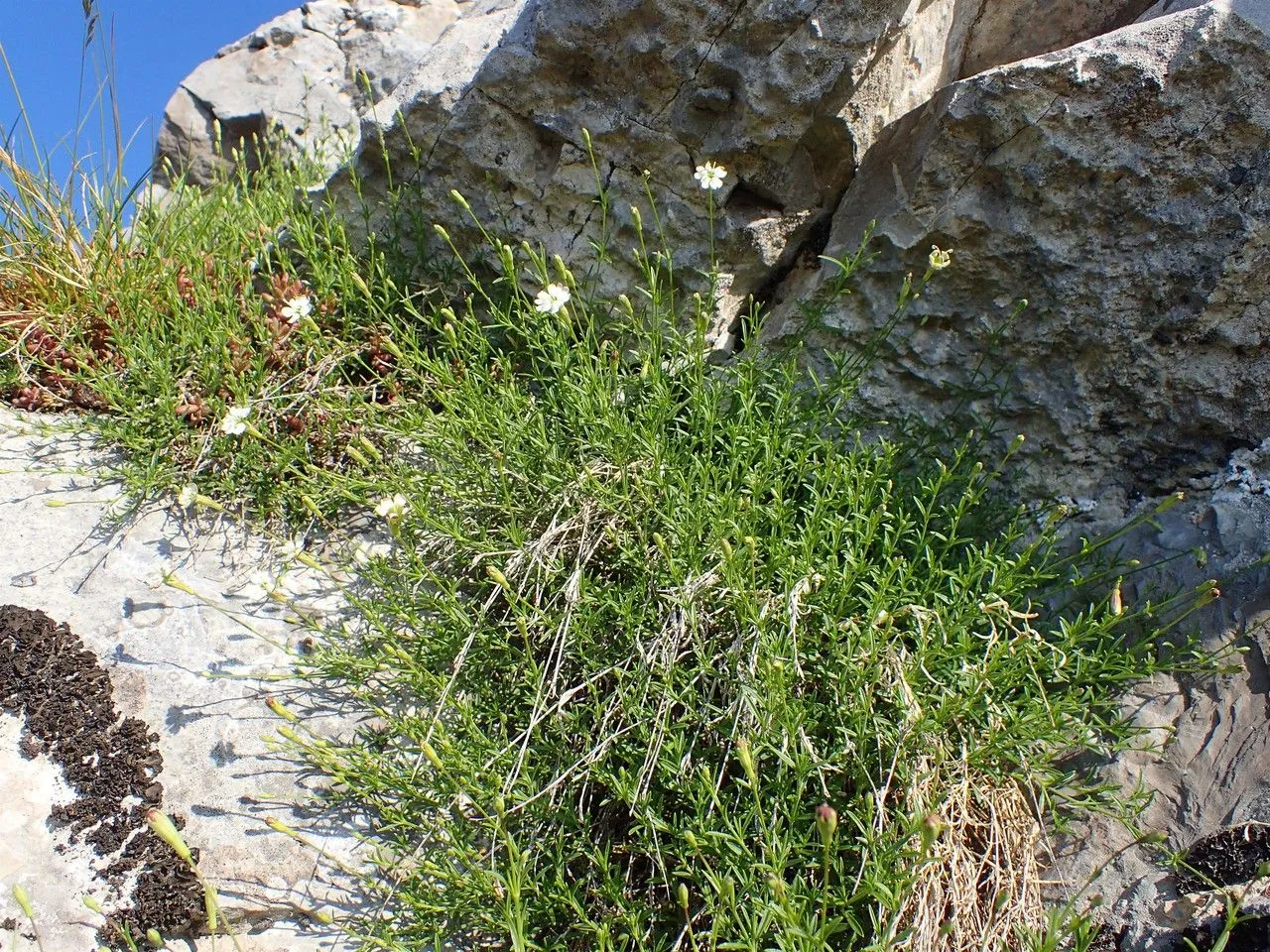
Author: L.
Bibliography: Sp. Pl.: 421 (1753)
Year: 1753
Status: accepted
Rank: species
Genus: Silene
Vegetable: False
Observations: SC. & S. Europe
Tufted catchfly, scientifically known as Silene saxifraga, is a striking perennial herb that belongs to the family Caryophyllaceae. This fascinating species was first described by Carl Linnaeus in 1753 in his seminal work “Species Plantarum”. Native to southern and southeastern Europe, the tufted catchfly is known for its resilient nature and distinctive appearance.
The tufted catchfly typically thrives in rocky alpine and subalpine environments, where it forms compact, cushion-like tufts. These tufts, composed of dense clusters of basal leaves, form a robust foundation that helps the plant withstand harsh, mountainous conditions. The leaves themselves are narrow and lanceolate, often exhibiting a grayish-green hue that complements the rugged terrain of its natural habitat.
Flowering usually occurs during the summer months, when the plant produces its characteristic five-petaled blossoms. These petals are typically white or pale pink, delicately notched at the tips, and often exhibit a subtle veining pattern. The flowers’ aesthetic appeal is enhanced by the plant’s ability to produce copious amounts of blooms, thereby creating a visually stunning display against the stark backdrop of rocky slopes.
Aside from its ornamental value, tufted catchfly plays a crucial ecological role in its native regions. The flowers attract a variety of pollinators, including bees and butterflies, which are essential for the ecosystem’s health and biodiversity. Furthermore, the plant’s presence helps to stabilize soil and prevent erosion in its mountainous environments, contributing to the overall resilience of these ecosystems.
In cultivation, Silene saxifraga can be a valuable addition to rock gardens and alpine-themed landscapes. It requires well-drained soil and a position that receives full sun to partial shade. Gardeners often admire this plant for its low maintenance requirements and its ability to flourish in conditions that mimic its natural mountainous habitat.
In conclusion, the tufted catchfly, Silene saxifraga, is a remarkable species celebrated for both its beauty and its adaptability. Its historical documentation by Linnaeus and its enduring presence in European alpine regions underscore its significance both botanically and ecologically. Whether observed in the wild or cultivated in gardens, this resilient plant continues to captivate and contribute to the biodiversity of its environment.
Deu: steinbrech-leimkraut
En: Tufted Catchfly
Ca: Silene pedrera
Fr: Silène saxifrage
De: Steinbrech-Leimkraut
It: Silene sassifraga
Es: Hierba de las piedras
: Tufted catchfly
Taken Jun 15, 2022 by Llandrich anna (cc-by-sa)
Taken May 23, 2022 by Sarzah (cc-by-sa)
Taken Jun 23, 2017 by Tela Botanica − Liliane ROUBAUDI (cc-by-sa)
Taken Jun 23, 2017 by Tela Botanica − Liliane ROUBAUDI (cc-by-sa)
Taken Oct 21, 2021 by Diego Alex (cc-by-sa)
Taken Jun 23, 2014 by Tela Botanica − Jean-Jacques HOUDRÉ (cc-by-sa)
Taken Jun 5, 2011 by Tela Botanica − Paul FABRE (cc-by-sa)
Taken Jul 13, 2019 by 1985 Simone (cc-by-sa)
Taken Jul 19, 2020 by Alain Bigou (cc-by-sa)
Taken Jun 17, 2019 by Nico Nicola Bertuccelli (cc-by-sa)
Taken Jun 3, 2017 by Yoan MARTIN (cc-by-sa)
Taken Jun 3, 2017 by Yoan MARTIN (cc-by-sa)
Taken Jun 3, 2017 by Yoan MARTIN (cc-by-sa)
Taken Jun 5, 2011 by Tela Botanica − Paul FABRE (cc-by-sa)
Taken Jun 23, 2014 by Tela Botanica − Jean-Jacques HOUDRÉ (cc-by-sa)
Taken Jul 14, 2022 by JeanRene (cc-by-sa)
Taken Jun 3, 2017 by Yoan MARTIN (cc-by-sa)
Taken Jun 15, 2022 by Llandrich anna (cc-by-sa)
Taken Jun 3, 2017 by Yoan MARTIN (cc-by-sa)
Taken Jun 23, 2014 by Tela Botanica − Jean-Jacques HOUDRÉ (cc-by-sa)
Taken Jul 15, 2004 by Photoflora – Benoit BOCK (©)
Taken Jul 15, 2011 by Photoflora – Benoit BOCK (©)
Taken Jan 1, 1970 by Photoflora – L’Abbé COSTE (©)
Taken Jul 15, 2008 by Photoflora – Benoit BOCK (©)
Taken Jun 16, 2013 by Tela Botanica − Bertrand BUI (cc-by-sa)
Taken Jun 18, 2019 by MICHEL DUSSERE (cc-by-sa)
© copyright of the Board of Trustees of the Royal Botanic Gardens, Kew.
© copyright of the Board of Trustees of the Royal Botanic Gardens, Kew.
© copyright of the Board of Trustees of the Royal Botanic Gardens, Kew.
Bloom months: [‘jun’, ‘jul’, ‘aug’]
Family: Myrtaceae Author: (F.Muell.) K.D.Hill & L.A.S.Johnson Bibliography: Telopea 6: 402 (1995) Year: 1995 Status:…
Family: Rubiaceae Author: Pierre ex A.Froehner Bibliography: Notizbl. Bot. Gart. Berlin-Dahlem 1: 237 (1897) Year:…
Family: Sapindaceae Author: Koidz. Bibliography: J. Coll. Sci. Imp. Univ. Tokyo 32(1): 38 (1911) Year:…
Family: Asteraceae Author: A.Gray Bibliography: Pacif. Railr. Rep.: 107 (1857) Year: 1857 Status: accepted Rank:…
Family: Fabaceae Author: Medik. Bibliography: Vorles. Churpfälz. Phys.-Ökon. Ges. 2: 398 (1787) Year: 1787 Status:…
Family: Aspleniaceae Author: (Cav.) Alston Bibliography: Bull. Misc. Inform. Kew 1932: 309 (1932) Year: 1932…